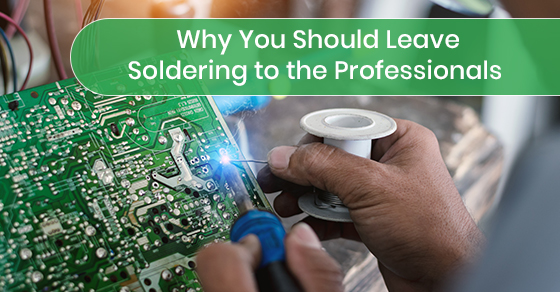Why You Should Leave Soldering to the Professionals
Most experts agree that soldering should be left to companies that specialize in professional soldering services. Soldering is essential to the engineering and manufacturing of a myriad of electronic components in the industry. It involves a level of detail and craftsmanship that is hard to find.
Many people may assume that soldering is very easy to do, based on a quick Google search, even though nothing could be further from the truth.
While we encourage people to expand their horizons and learn new skills, soldering is one of those areas where professional soldering services would be the recommended course of action to take, given some of the serious risks involved. Here, we will delve into why you should leave soldering to professional soldering services in the area.
Soldering 101
The setup process for soldering is actually quite simple. Many websites can be accessed that provide helpful step by step tutorials that you can follow if you wish. The supplies needed are quite inexpensive if you know where to look, which may explain why so many people seem eager to start soldering on their own.
However, if you are not confident in your soldering skills, have a printed circuit board that needs to be repaired, or are completely new to the world of soldering, then perhaps sending your printed circuit boards out for repair may be the ideal solution.
Burns may Occur
Soldering irons can be very hot to the touch, so the risk of burning yourself is a very real one. In fact, soldering irons can exceed 600 degrees Fahrenheit. At such a high temperature, you can expect your skin to become severely burnt if you brush against it.
Negligence or ineptitude may also cause melted solder to drip onto personal effects or one’s limbs, causing instant burns. In fact, even failing to set the iron down in a proper fashion can start a fire in record time. You will also need to worry protective eyewear while you work, as solder can splatter and cause blindness in severe cases.
Fume Inhalation
Solder can be obtained in both lead-free and leaded variants. It should also be noted that most people will opt for a lead version, even though it contains high levels of toxins. This is because the lead version boasts superior workability and strength properties over its non-lead counterpart.
Lead-free solder isn’t as toxic as it may seem but is often the only viable option in countries where leaded solder use is banned. Regardless of which option you choose, both can cause serious harm to the eyes and can also lead to severe health issues if you inhale the fumes produced by the solder.
You will need the proper ventilation set up before you begin to solder, which will likely not be an option for most beginners due to financial and logistical constraints. The general rule of thumb for those who have the proper ventilation arrangement is to have at least ten inches of space between their work and their face before they begin soldering.
Poor Technique
Many experts agree that there is a steep learning curve involved in proper soldering, so you may need to spend countless hours working on your technique until you get the hang of things.
In the beginning, you may accidentally use too much solder. The excess solder may end up inadvertently creating a solder bridge that may end up affixing 2 adjacent points.
Or, the opposite may occur, whereby you fail to use sufficient solder. In such a scenario, subpar electrical continuity may occur from the component to the board. You may also accidentally ruin the join via yanking or pulling, so you should try and avoid any quick or sudden jerking motions while you are soldering.
In addition, if you are having issues while soldering, you don't necessarily need to panic, as creating a poor connection is very easy, and is something that even occurs to experts in some instances.
Tining is also something that you need to look into, as you will need to learn when to tin the edge of the iron. De facto, improper tinning may lead to short-lived and poor connections, or may even cause the solder to ball upon itself.
Poor connections may be triggered by a lack of proper board cleanliness or even inadequate heat levels. As an added tip, we would recommend that you keep the tip of the iron clean via a wet sponge. You should also avoid excess moisture at the same time, as too much moisture may lower the temperature of the iron for a brief duration.
Inadequate Component Knowledge
A lack of component knowledge is arguably one of the main reasons why soldering is best left to professionals. For example, a lack of familiarity with printed circuit board components or printed circuit board repair may cause certain components to be damaged during the soldering process.
What’s more, the temperatures required to solder will lead to the weakening of the glues used within the boards. As a result, they may separate and lift if your hands aren't steady enough. If you fail to use the heat clips/sinks as intended, then the heat generated during soldering can damage some of the more sensitive parts of the circuit board.
As an added tip, the components that are most static prone and sensitive should be worked on and installed at the end, as doing so will reduce the risk of damage during the reassembly process.
To learn more about soldering and why you should leave it to the professionals, call Circuits Central at 888-821-7746 or contact us here.

